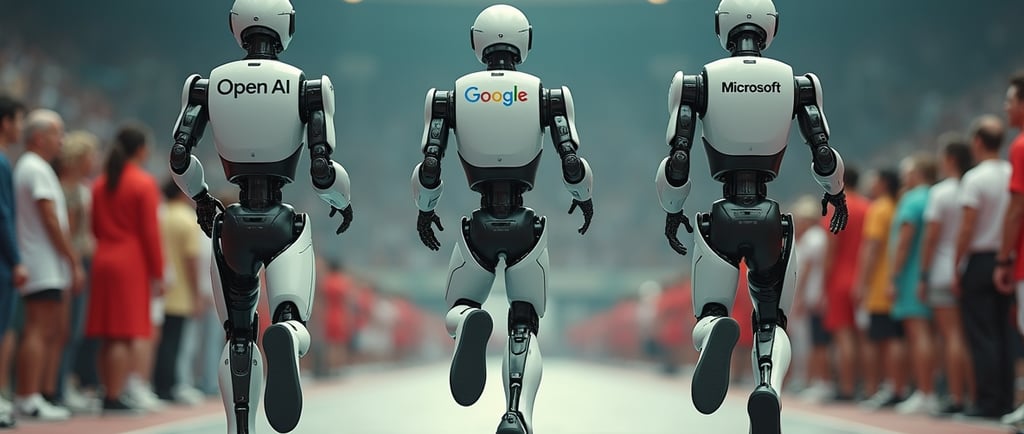The AI Adoption Race: How Google, Microsoft, and OpenAI Battle for Your Day
In the AI adoption race, brilliance isn’t enough. Google and Microsoft are embedding AI into billions of users’ daily lives, giving them a distribution edge. OpenAI faces a tough climb, but the future belongs to those who master the workflow. Explore how the battle for digital influence is shaping the next era of AI.
EN
10/21/20253 min read


OpenAI may have built some of the most sophisticated models in the world. But in the battle for adoption, brilliance isn’t enough. The real challenge lies in distribution, and here, Google and Microsoft hold home-field advantage. To understand why, we need to look at how both of these tech titans are embedding AI into the everyday lives of billions of people and businesses.
Google: Owning the Doorway
Google has an almost unfair advantage, its AI doesn’t need to be discovered, marketed, or sold. It’s simply folded into what billions already use.
Search: Google handles ~16.4 billion queries per day. That’s not just scale, it’s habit, ritual, reflex. Recently, AI Overviews started surfacing answers directly in search, now reaching 1.5–2.0 billion people monthly. That’s more distribution than most entire industries combined.
Workspace: More than 3 billion people use Gmail, Docs, Sheets, and Drive, with around 11 million paying business customers. Imagine waking up and AI is already in your inbox, your calendar, and your slides, no onboarding, no extra effort.
Gmail: With ~2.5 billion users, it remains the world’s default inbox. Here, AI doesn’t need to fight for attention; it seamlessly rides along with users’ daily routines.
Subscriptions: Google One now has 150 million paying subscribers, showing Google knows how to layer monetization on top of its free-first strategy.
Google’s Secret Weapons: Free AI at Scale
Google isn’t just innovating; it’s lowering the barrier of entry with powerful free tools:
Nano Banana / Gemini 2.5 Flash Image: AI-powered image editing and generation baked into Gemini.
Veo 3: Turn text into short 8-second video clips, audio included. Creators get video capabilities at zero extra cost.
AI Studio: A free sandbox for developers and creators to prototype with Gemini.
Flow: Google’s cinematic storytelling tool combining text, image, and video into compelling narratives.
Gemini Code Assist (free tier): Coding help with generous limits, democratizing dev tools.
NotebookLM: An AI-powered notebook for summarization, reasoning, and collaboration, now with sharing capabilities.
With this ecosystem, Google ensures users don’t even have to think about switching to an “AI tool.” The AI simply shows up in the doorway they already walk through every single day.
Microsoft: Dominating the 9-to-5
If Google owns the morning search ritual, Microsoft owns the 9-to-5.
Microsoft 365: With over 430 million paid seats, it’s the operating system of corporate life. From finance teams in Excel to managers in Outlook, AI shows up where people already work.
Azure: Over 95% of Fortune 500 companies use Azure. That’s not just infrastructure dominance, it’s the enterprise trust factor. If your company already depends on Azure, adding Microsoft AI is a no-brainer.
Copilot: Roughly 70% of Fortune 500 firms have adopted Microsoft Copilot. It’s not just a tool; it’s embedded in Word, Teams, and Outlook. Employees don’t have to ask, “Should I try AI?”it’s simply there, waiting to autocomplete their next move.
Microsoft doesn’t need to convince IT buyers to switch. AI is bundled in, like electricity in an office building. You don’t opt into electricity, you just flip the switch.
OpenAI: Running the Extra Mile
And here lies OpenAI’s dilemma. Without a search engine or an enterprise monopoly, it has to run harder, faster, and smarter. It has to prove its worth in spaces where Google and Microsoft are already considered the “default.”
The uphill climb:
B2C Challenge: Competing with Google’s free, embedded AI means OpenAI must either deliver an undeniably superior experience or invent entirely new categories of interaction.
B2B Challenge: Competing with Microsoft means fighting against deeply entrenched software suites. Enterprises don’t want “yet another vendor” unless the value proposition is extraordinary.
Pricing Pressure: Google’s free-first strategy and Microsoft’s bundling compress the price umbrella for independent AI services.
Where OpenAI can still win:
Vertical Depth: Go deeper than the defaults. Build workflows for industries where “good enough” isn’t actually good enough: law, medicine, design.
Interoperability: Seamlessly integrate into multiple ecosystems. Become the connective tissue, not the silo.
Trust and Governance: Offer unmatched transparency, compliance, and security to win over hesitant enterprises.
Speed of Innovation: Without legacy products to protect, OpenAI can be bolder, faster, and more experimental.
The Numbers at a Glance
Google Search: ~16.4B queries/day
AI Overviews: 1.5–2.0B monthly users
Workspace: >3B users, ~11M paying business customers
Gmail: ~2.5B users
Google One: 150M subscribers
Microsoft 365: >430M commercial seats
Azure: Used by >95% of Fortune 500
Copilot: Adopted by ~70% of Fortune 500
Perspective: Why This Battle Matters
The race isn’t about whose model is smarter. It’s about who controls the entry points of our digital lives. Google owns discovery. Microsoft owns productivity. Together, they create a moat around billions of users.
OpenAI’s future depends on finding a third axis. Not doorway. Not workday. Something else. Maybe it’s workflow orchestration, maybe personal AI agents, maybe entirely new behaviors we haven’t imagined yet. That’s the holy grail.
Closing Thought
Google owns the doorway. Microsoft owns the workday. If OpenAI wants to win, it must own the workflow, with deeper outcomes, safer integrations, and less friction than the defaults. The extra mile isn’t optional, it’s survival.
AI is changing the world FAST. Are you changing with it?
© 2025. ChangeAI, all rights reserved.


